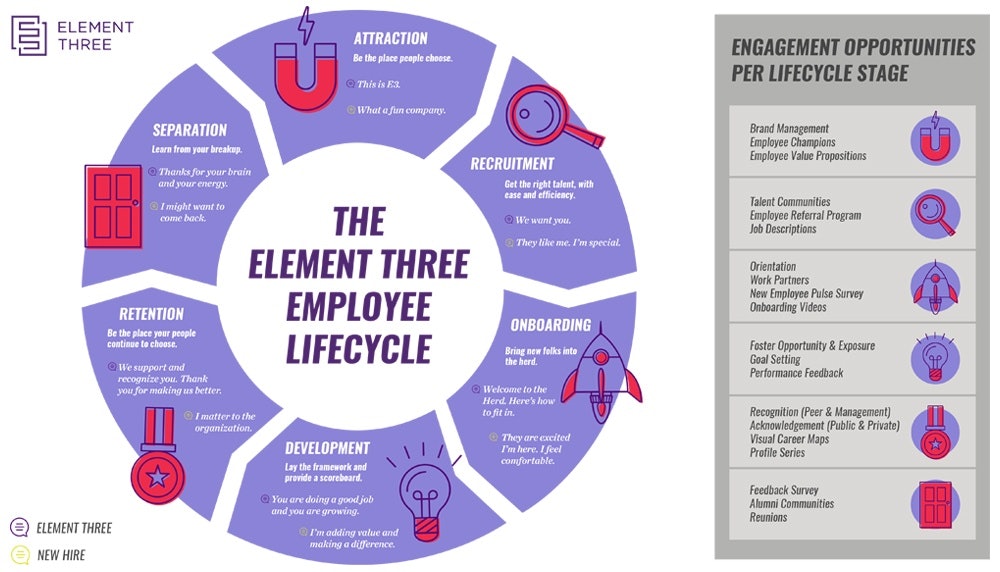“To win in the marketplace you must first win in the workplace.” Doug Conant, the former CEO of Campbell’s Soup, is the man to credit for this piece of wisdom. And it’s true, especially in a service industry. If the people inside your walls are not thriving, you can bet they are not showing up for your customers the way you expect or want them to.
So, how do you ensure you are winning in the workplace? First, you need engaged employees. At Element Three we recently defined our employee lifecycle and developed a strategy to increase engagement by educating and supporting our people leaders in their efforts to engage the folks they manage. But before you can get to a strategy, you first need to understand what employee engagement is not, and ultimately what it is.
What Is Employee Engagement?
Employee engagement is not employee happiness: you can be happy while unproductive and uncommitted. Employee engagement is also not employee satisfaction: you can be satisfied while coasting and not giving something your full energy. So what is employee engagement? Employee engagement is the emotional commitment an employee has to the organization and its goals.
Cool, but what does that look like in practice?
Engaged employees speak positively about the organization to co-workers, potential employees, and customers. They stay because they feel an intense sense of belonging and a desire to be a part of their organization. And they strive because they are motivated to exert effort for the success of their jobs and the organization.
What Does Employee Engagement Mean for the Bottom Line?
How does winning in the workplace help you in the marketplace? Let’s take a look at some stats:
- Organizations with higher employee engagement levels experience 10% higher customer metrics, 21% more productivity, and 22% more profitability.
- Organizations with highly engaged employees had an average three-year revenue growth of 20.1% versus the average 8.9% revenue growth rate, and had employees who were three times more likely to be top performers (McClean & Company)
I think we can agree the more engaged, motivated, and connected your employees feel to your organization, the better they will perform for you and, ultimately, the customers you serve.
What happens when you have a disengaged workforce? How does losing in the workplace hurt you in the marketplace? According to the human resources research and advisory firm McClean & Company, disengaged employees cost organizations $3,400 a year for every $10,000 in salary. This probably feels abstract and theoretical, so I am going to throw together a hypothetical application to put it into perspective.
Company XYZ employs 200 people with an average salary of $50,000 annually. Per the data from their most recent engagement survey, 30% of their workforce is disengaged (the global average for disengagement is ~60%). Given the statistic from McClean & Company, XYZ is losing ~$1,000,000 due to disengagement.
A disengaged workforce costs you both culturally and financially. Culturally, disengagement makes your workplace less enjoyable for everyone, and can even hurt your perception externally. Financially, disengaged employees are likely not performing to their standards, meaning no matter how much you invest in your people, the results won’t come.
It’s clear disengagement is no good for your culture or your bottom line, which means if you’re not doing something about it, you probably should. A good first step to tackling engagement starts with understanding your employee lifecycle so you are then able to craft an engagement strategy and meet people where they are in their journey.
What Is an Employee Lifecycle?
An employee lifecycle represents the different stages employees advance through as they navigate an organization. It’s similar to a customer lifecycle, only applied internally. Rather than thinking about how to nurture your customers through the different stages of the lifecycle, you think about how to engage your employees to ensure they continue to choose your organization as their place of work.
After you have your employee lifecycle defined, you need to take a look at your workforce and determine where they are in their employee lifecycle. The best way to go about this is to have your department and/or people leaders place the folks they manage within a lifecycle phase. You’ll first need to establish and align on the criteria for each phase; for example:
Onboarding
First 90 days of employment
Development
Actively learning
Requires opportunity and exposure to mature knowledge and skill
Entry and/or mid-level in their discipline and role
Retention
Actively teaching
Mature in both knowledge and skill
Senior and/or advanced in their discipline and role
Let’s say you are the Director of Customer Success at a SaaS company, and after going through the exercise of identifying your employee lifecycle and categorizing your team, you realize 80% of the folks you manage fall within onboarding and development. This is an indication that you should focus your efforts on engagement opportunities within onboarding and development in order to address the needs of the majority of your team. It also is an indication that you should begin thinking about how to develop and/or source the future leaders of your team.
Engagement Opportunities
After you’ve defined the employee lifecycle for your organization and identified what phase of the lifecycle your workforce is in, it’s time to take a look at the engagement opportunities across the different phases of the lifecycle.
The chart below illustrates some example engagement opportunities. Take a look and see how many of those boxes you think your company kicks butt at, and also how many of those boxes would be left blank. At Element Three we check ten of those boxes really well, we check six of them pretty well, and in the remaining eight we have some room for improvement.
For example, we kind of suck at training, so we could benefit from developing some training videos for folks during the onboarding phase to better prepare them for theoretical, technical, and functional aspects of their role.
What Now?
Armed with a better understanding of employee engagement and what it means for your bottom line, here are eight things to take away and try on for size at your organization. Ideally, these steps will help combat disengagement and allow you to take strides towards building a thriving workplace so you can win in the marketplace.
- Establish an engagement baseline: how engaged are your people right now? Do you have the ability to measure this currently? If not, what can you do to get a pulse on how engaged/disengaged your workforce is? (Nationally, 32% of workers are considered “engaged”… yikes!)
- Define your lifecycle: what does your employee lifecycle look like? There are lots of examples out there, do some research and figure out what makes sense for your organization.
- Break down your workforce: after your lifecycle is defined, take a moment and assess where your people are in their journey.
- Assess yourself: take a look at the engagement opportunities list and determine what you do well, what needs to be improved, and what needs to be activated.
- Bring focus: after you’ve identified the breakdown in your workforce and assessed yourself on the engagement opportunities board, take a moment and prioritize what is important to focus on now in order to move the needle.
- Think ahead: in addition to figuring out what is a priority now, you should also plan for future initiatives. Perhaps you want to improve your training process by creating videos—make sure to plan for that in your budget.
- Define the tactics: after you understand where you need to focus, break it down into tactics. Let’s say you are looking to focus on retention and you plan to do so through recognition. What does that look like? Are you going to create a peer-to-peer recognition program?
- Implement: now it’s time to get to work.







